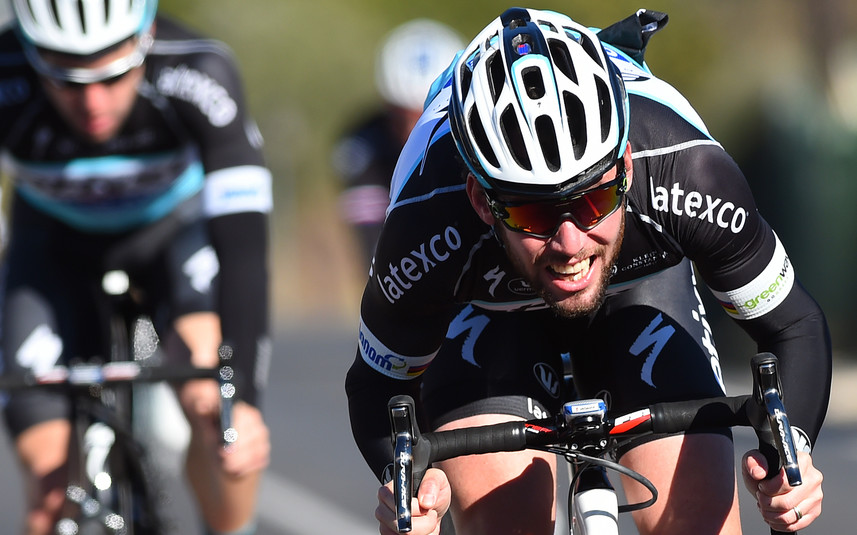
Specialized Racing provided Etixx - Quick-Step with pre-race analysis of Milano-Sanremo! The details are below.
Overview
Milano – Sanremo is one of the most unpredictable races in the entire cycling calendar. There are three important elements that in the last editions have characterized this race, elements that we have taken some time to analyze.
The first one is represented in the initial five hours of the race that include the climb of Turchino and Cipressa, but also the entrance on the coastal road of Liguria.
The second one is represented by the climb and consequent descent of the Poggio. And the third one that brings the riders to the final Kilometer of the race.
The first five hours
The first hours of the race is a battle to stay as hidden as possible to save as much energy as possible. If being positioned in the middle of the peloton is the way to go, adding the right choice of equipment helps a rider to save even more.
Things to analyze are the different roles of the riders, including the one of the domestiques that will have to control the race in the front, according to the respective teams’ strategies. Being very exposed, aerodynamics is very important as it gives longevity to the effort.
Even though the first part of the course sees the climb of Turchino and Cipressa, aerodynamics is still a factor given the high speed at which these two climbs are negotiated.
- Going from a Prevail Helmet to an Evade Helmet saves 85kJ or roughly the equivalent of one Energy Gel
- The draft a potential winner gets from just one rider over this segment equals 600kJ (7 Energy Gels), if he spends the entire time deep in the pack he even saves 1500kJ (18 Energy gels)
- The Energy saving effect of the Evade Helmet still holds true, when deep in the pack.
The Poggio Element
The climb
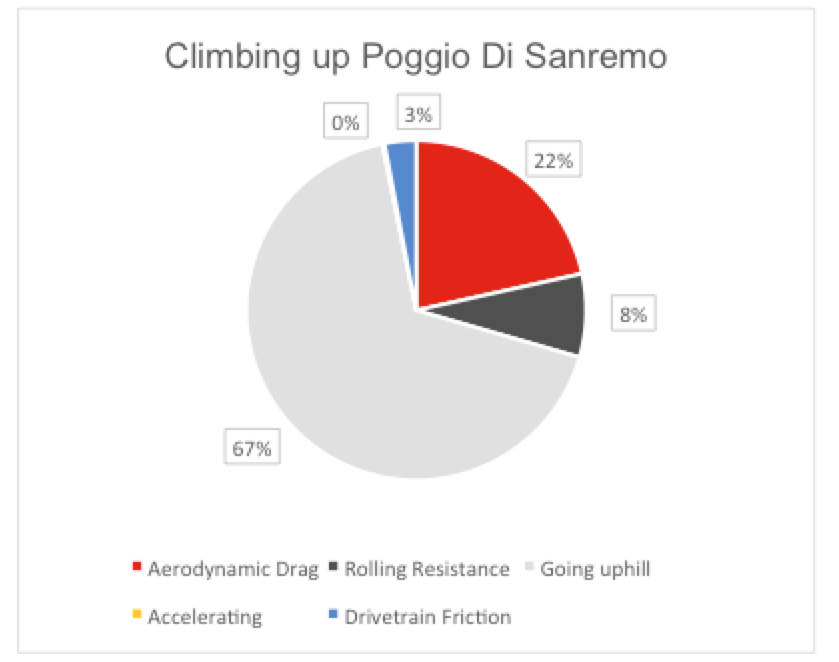
- Even though gravity is the biggest resistance going up the Poggio, it is still a balancing game of aerodynamics and weight. An aero set up consisting on the Venge still saves 6 Watts over a Tarmac during this climb.
- We estimate that the climb will be ridden in less than 7’ that makes of it a very fast ascent. While riders less prone to sprint will be maximizing their effort along the Poggio, sprinters will try to save the loss as much as they can. Staying as close as possible with the top of the field by limiting their gaps will help them to recover along the fast and winding descent.
The Descent
- The Poggio descent is fast and winding and it will be headed at a high speed. Less than 5’ for regroup, in case a rider has been left behind during the ascent of the Poggio. The effort will be violent and can show relevant power consumption, even though it is a downhill.
- Aero is still relevant, along with another component, the combination of tires and wheels. Specialized has develop a huge knowledge in tires performance and the Specialized Turbo is the result of it. Low rolling resistance and great grip is what’s needed in extreme situation like the Poggio descent. Even more with rainy conditions.
- Teams along with Specialized Racing are working extensively on defining the best tire pressure and to make sure the riders arrive at the Poggio with the right conditions.
- Going down the Poggio a rider has to rely on fast wheels, with a great brake performance and an incredible acceleration. Most of our top riders will be racing the Roval CLX 60 as it is a combination of all the features a rider is looking at.
The Sprint (Last Kilometer)
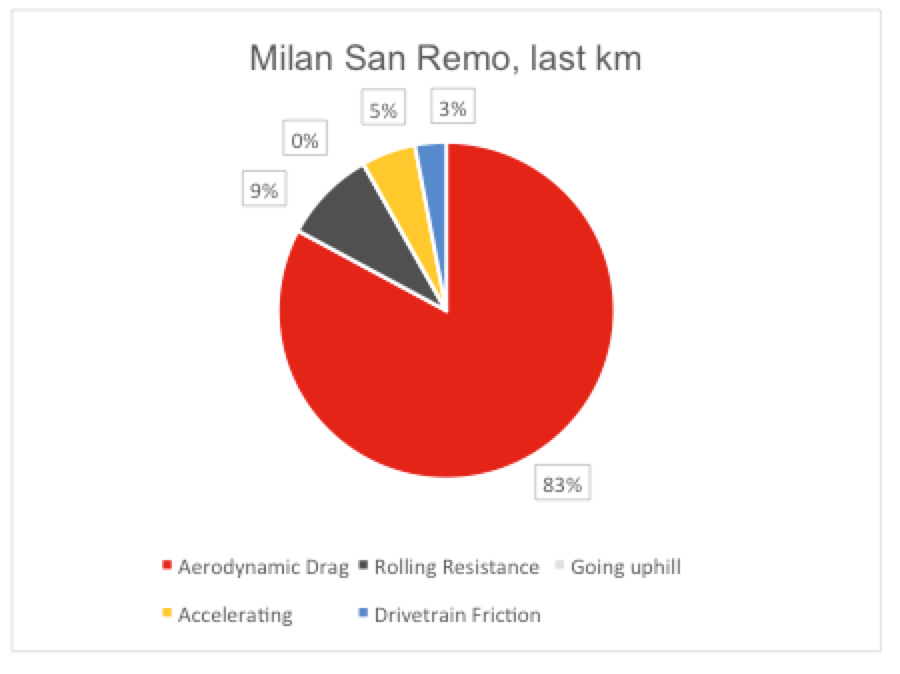
- In the last km aero truly is everything. 83% of the overall resistance is aerodynamic resistance, showing that the air and not the weight is the athlete’s biggest enemy.
- One Example: in case of a sprint finish, a sprinter starts his final surge with about 200m to go. He cranks the pedals hard, reaching maximum power three seconds into the surge and accelerates quickly. Let’s suppose that sprinter A on the Venge completes the 200m in 11.7 seconds. His identical opponent, sprinter B that produces the same power at the same time, uses a Tarmac. He reaches the finish in 11.8 seconds or roughly 1.5 meters behind sprinter A.
CONCLUSIONS
Milano-Sanremo is a long race where aerodynamics plays a big role, but there are other elements a rider must consider if he wants to aim for the ultimate success.
This Classic is difficult to be interpreted and it requires a lot of attention to the details when it comes to selecting the right equipment.
From the domestique to the leader, the set ups need to be selected with care, as they can change a lot to the final result.
Specialized best set up for Sunday consists in:
- Venge;
- Roval CLX60
- Specialized Turbo
- Evade Helmet

The Importance of Fluid and Sodium Intake for Athletes
Fluid
Water is the most important constituent of our body. About 45% to 75% of our body consists of water (Jequier, 2010). The total amount of water in the body depends on the individual's weight, age, sex and body composition (Altman, 1961).
Well-trained athletes have a larger amount of water in their body than less well-trained athletes. The professional cyclists of the Etixx-Quick Step team are therefore able to cope with extreme weather conditions, such as those that were present at the Tour of Qatar and the Tour of Oman. In relative terms, these cyclists have more muscles than would an amateur cyclist. Muscles consist of 70%-75% water, while fat tissue contains only 10-15% water (IOM, 2005).
Because water is an important component of the vascular volume (by volume, blood consists of approximately 55% to 65% water (plasma) and 35%-45% red blood cells) hydration also plays a crucial role in our cardiovascular function and the regulation of body temperature. Water fulfils a very important role in our body. It is a building material, means of transport, solvent, heat regulator, partner in chemical reactions and plays a protective role (De Winter, 2008; Maughan, 2000).
Fluid Balance
The fluid balance, i.e. input versus output, is affected by the intake of food, level of activity, age and certain environmental factors (e.g. altitude/heat). While the total water balance is strictly regulated over a 24-hour period (IOM, 2005), shortages or excesses can occur. Dehydration develops when an insufficient amount of fluid is ingested or when a lot of fluid is lost. Again, as an example of extreme climates, Qatar and Oman have a desert climate. But this can apply to any race with high temperatures and little rain. The absolute temperature in February at a place like Qatar and Oman is not too bad, around 23°C. But in relative terms, it is the first time during the season that the cyclists race in hot weather. The danger of drinking too little looms just around the corner. In addition, the wind plays an extra role in these races. Cycling in fan formation requires a lot of concentration, and sometimes makes it difficult to drink enough. Drinking when thirsty should be a habit for athletes.
Before
It's important to get off to a great start to finish the race in a great position! The same applies to a healthy fluid strategy. Drinking during the race only is not enough to maintain an adequate fluid balance. Cyclists will already be loading up with fluids and electrolytes at breakfast and when making their way to the start. Athletes who start their effort with an inadequate water balance will perform more poorly than when they arrive at the starting line fully hydrated (Ronald, 2001). When expending effort, the water content in the muscles increases, while it will decrease in the blood plasma as a result of muscle contractions. The water content will decrease further as a result of dehydration due to sweating.
Factors Affecting Dehydration (Sawka, 2007):
Genetic factors: some athletes sweat more than others;Body size: taller athletes tend to sweat more than smaller athletes;Environment: more dehydration in hot and humid circumstances;Intensity of the effort: more dehydration during higher training intensity.
The amount of plasma fluid in the blood is very important for the body. A decrease in the plasma volume will result in a decrease of the blood volume, which automatically results in a reduced supply to the muscles. Reduction of the body's water content will have a great impact on the athlete's ability to perform (Jeukendrup, 2004). Dehydration causes the following negative effects: increased heart rate, reduced heat resistance, the expenditure of effort feels more difficult than normal, the ability to concentrate is reduced, the skill level is reduced and the stomach empties more slowly, which results in gastrointestinal problems. It has been definitively proven that dehydration has a negative impact on performance and that this impact increases as the loss of fluid increases (see also the table on sweating during sports performance) (Jeukendrup, 2004).
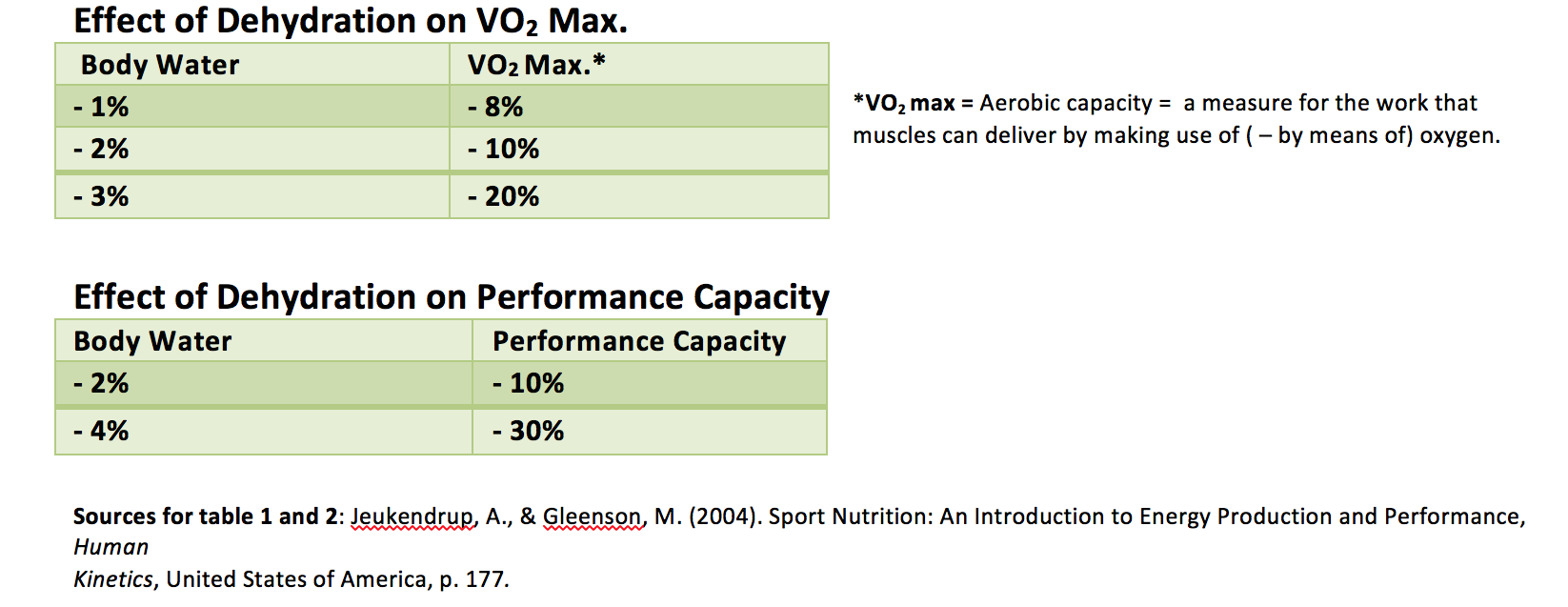
Supposing a cyclist who normally pedals 420 watts, the loss of performance will be 42 watts in the case of 2% dehydration and 126 watts in the case of 4% dehydration. In terms of speed, for a top performance of 45 km per hour, 2% dehydration reduces the speed to 40.5 km per hour. In the case of 4% dehydration, the speed slows to 31.5 km per hour. This must absolutely be avoided when you are striving for victory.
The Impact of the Loss of Sweat on a Sports Performance (Nelissen, 1999).

Most athletes can tolerate a 2% dehydration when the environmental temperature is cold (5-10°C) or moderate (21-22°C). However, in a hot environment (>30°C), a 2% dehydration of the body weight will always have an impact on performance. The table below clearly illustrates that performance decreases drastically as temperature rises.

Table: Theoretical Effects of Dehydration on Endurance Performance During Prolonged Exercise in Environments that Vary in Temperature from 5 to 30°C. (Sawka, et al. 2000).
The symptoms of hypohydration depend on the severity of the dehydration.
The symptoms of mild dehydration are: thirst, dry or sticky mouth, decreased urine output, dark yellow urine colour, headache and muscle cramps.
Serious symptoms of dehydration are: no urine output, a very dark yellow or orange urine colour, shrivelled skin, increased irritability, dizziness, accelerated heartbeat and breathing, sunken eyes, shock (due to a reduced flow of blood through the body) and unconsciousness. Cyclists and their support crew diligently monitor for signs of extreme dehydration. In the past, race conditions for the Tour of California have caused cyclists to faint and to become completely exhausted and dehydrated. The question remains whether cycling at temperatures of 50°C is humanly possible. Hypohydration is a danger for every athlete: sooner or later, he or she will be confronted with this phenomenon. However, the remedy is simple: by drinking regularly throughout the day and during the effort (training/race), these terrible consequences can be avoided.
However, beware: feeling thirsty is a warning to prevent the body from losing too much fluid, but it is not an adequate compass to regulate drinking behaviour. Thirst occurs when the loss of fluid amounts to about 2% of the body weight. Once a feeling of thirst is experienced, it is actually already too late to maintain performance at the required level. That is why athletes have to learn to drink before they get thirsty. On top of that, the thirst reflex may disappear altogether during intensive efforts.
Electrolytes
The amount of electrolytes you lose depends on the amount and composition of your sweat. Both these factors vary strongly according to the physiology of the athlete in question and the external conditions in which the effort is expended. Therefore, it is very difficult to provide a precise picture of the amount and nature of the electrolytes contained in the sweat of a specific athlete (Maughan, 2000). At a professional level, this is often determined through individual sweat tests. Some athletes lose up to 1500 mg sodium per hour. They require a customised approach. In extreme weather conditions, in addition to the salts present in the ISOTONIC, salts will also be added in the form of ORS (Oral Rehydration Solution).
Sodium
Sodium ensures that the water in our body is better retained. This may be explained as follows: if you were to only drink water during the expenditure of effort, the sodium levels in the blood would decrease. The resulting effect would be that less anti-diuretic hormone (ADH) would be excreted. ADH inhibits urine production. A reduction of this hormone increases urine production and accordingly increases fluid loss. When sodium is added to water, the sodium concentration in our body will be better maintained and urine production will not be additionally stimulated (Maughan, 2000; Ronald, 2001).
Sodium is chiefly present in sports drinks to improve the absorption of glucose: for each glucose molecule, one sodium molecule is required (Maughan, 2000). When glucose and sodium are transported over the bowel wall, water will also move in the same direction. Sodium and glucose actually draw the water along.
During the Tour of Qatar and the Tour of Oman, the cyclists were consuming two bottles (1 litre) per hour. This provided them with fluid, electrolytes and the necessary energy. Additional energy is derived from gels and bars. A good ISOTONE thirst quencher with enough sodium is a basic requirement for every athlete.
Practical Guidelines:
GENERAL
Before the Expenditure of Effort:
Start your training/race perfectly hydrated (Casa, 2000; Sawka, 2007).The athlete can verify this by checking the colour of his or her urine. If it is light yellow, the athlete is perfectly hydrated; if the urine is dark, the athlete did not drink enough and urgent top-ups are required.

It is generally recommended to drink 300 to 600 ml of fluid during the pre-race meal and another 300 to 450 ml in the last 15 to 20 min. before the expenditure of effort. Water only replenishes fluid and is mainly suitable for shorter efforts. KH/electrolyte drinks (sports drinks) not only help you to replenish fluids, but also top up carbohydrates, which makes them more suitable for endurance races. Drinks with added salts, like most sports drinks, can also be useful to improve fluid retention prior to and during the expenditure of effort (Burke et al., 2010).
It is important for the athlete to have an idea of his/her personal dehydration during the effort (Sawka, 2007). This is really not so difficult: by weighing yourself before and after the effort, you will know exactly how much fluid was lost during the expenditure of effort. Every kilogram (kg) of weight lost equals about one litre (L) of fluid. This amount is added to the amount of fluid ingested during the expenditure of effort. The sum of both provides a reliable estimate of the total dehydration during the expenditure of effort (Cheuvront, 2004).
For example: an athlete who is 1 kg lighter after a training session and who ingested 1 litre of fluid during a training session, has lost a total of 2 litres of fluid during the expenditure of effort. As soon as an athlete knows what his or her individual fluid losses are, he or she will be able to prepare an individual plan.
During the expenditure of effort:
For expenditures of efforts of < 1 hour, the athlete must simply follow his or her thirst reflex and drink as much as he or she sees fit. Athletes with an unreliable feeling of thirst (e.g. thirst due to stress, weather conditions, etc.) should try to drink as 'much as possible' to avoid dehydration of more than 2% body weight (Goulet, 2014).
It is best to prepare a plan for fluid intake in advance.
Start drinking from the start of the effort and regularly take small sips.
What should you drink?
What you should drink depends on the duration and intensity of the effort.
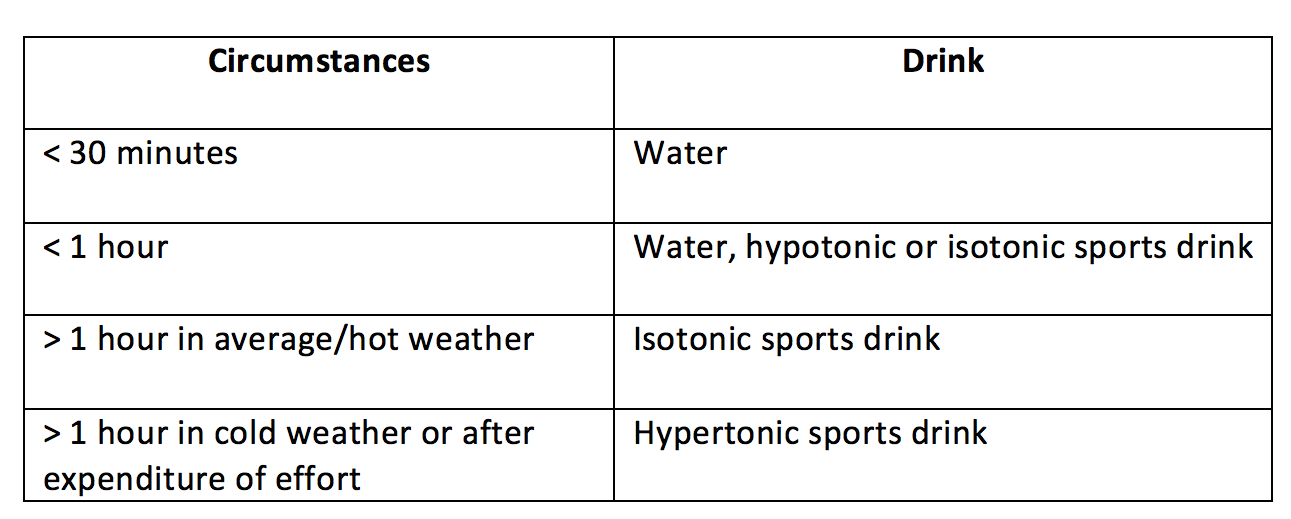
Hypotonic, isotonic or hypertonic sports drinks?
To find out which type of sports drink it is, just look at the sugar content per 100 ml on the packaging and/or the osmolarity.
Osmolarity refers to the number of dissolved particles in a drink. Water moves from the part with fewer dissolved particles to the part with more dissolved particles. According to the number of dissolved particles, sports drinks can be divided into hypotonic, isotonic and hypertonic sports drinks. A sports drink containing as many particles by volume as blood (290mOsm/L) is called isotonic. Such drinks usually contain between 4-8 g KH per 100 ml. A drink containing fewer particles by volume than our blood is called hypotonic. Such drinks contain <4 g per KH per 100 ml. A drink containing more particles by volume than our blood is called hypertonic (>8g KH per 100 ml). The osmolarity of the sports drink affects the emptying of the stomach. Hypertonic sports drink will stay in the stomach longer and thus supply less fluid than will isotonic and hypotonic sports drinks.

It is recommended to choose a sports drink that:
- contains 20 to 30 mmol/L (or 460 to 960 mg/L) sodium (Sawka, 2007).
- tastes good and motivates you to drink.
- may contain carbohydrates, depending on the duration of the effort.
- has an osmolarity below 500mOsmol (this is not always clearly stated on the label).
- has a temperature between 15-22°C (Szlyk, 1989).
- does not contain additives such as carbon dioxide, vitamins or caffeine.
- Take a few small sips from your drink every 15-20 minutes (150-300 ml), depending on your level of dehydration.
After the expenditure of effort:
- Replenish the amount of fluid you lost during the expenditure of effort.
- Drink 150% of the lost fluid within a period of 2 to 4 hours after the effort.
- A drink rich in carbohydrates may help replenish carbohydrates and fluid after the effort. Water only replenishes fluid.
- The drink should have a temperature between 10-15°C.
When the level of dehydration is significant (>2L) and/or quick rehydration is required, adding sodium to the drink may be recommended. Sports drinks and salty foods are ideal for this purpose (Burke et al., 2010).
Sources
- AIS, http://www.ausport.gov.au/ais/nutrition/faq/hydration
- Altman, P. L. (1961). Blood and other body fluids. Federation of American Societies for Experimental Biology. Washington, D. C.
- Armstrong, L. E. (2007). Assessing hydration status: the elusive gold standard. J. Am. Coll. Nutr., 26: 575S-584S.
- Arrief, A. I., & Kronlund, B. A. (1999). Fatal child abuse by forced water intoxication. Pediatrics. 103: 1292-1295.
- Casa, D. J., Armstrong, L. E., Hillman, S. K., Montain, S. J. (2000). National Athletic Trainers Association Position Statement: Fluid replacement for athletes. J. Athl. Tr., 35: 212-224.
- Cheuvront, S. N., Carter, R., Montain, S., & Sawka, M. (2004). Daily body mass variability and stability in active men undergoing exercise-heat stress. Int. J. Sport. Nutr. Exerc. Metab., 14: 532-540.
- Costill, D. L., Saltin, B. (1975). Sweatings: its composition and effects on body fluids. Ann. NY. Acad. Sci., 301: 160-174, 1984.
- Coyle, E. (2004). Fluid and fuel intake during exercise. Journal of Sports Sciences, 22, 39-55.
- Coyle, E. (2005). Chapter 4: fluid and fuel intake during exercise. In: Maughan, J., Burke, L., Coyle, E., editors. Food nutrition and sports performance 2. Routledge New York; p. 63-91.
- Institute of Medicine (IOM) (2005). Water. In dietary reference intakes for water, potassium, sodium, chloride, and sulfate. Washington, D. C.: National Academies Press., pp. 73-185.
- Been, A. (2006). The complete guide to sports nutrition: the young athlete. A&C Black, p155.
- Burke, L. & Deakin, V. (2010). Clinical Sports Nutrition. McGraw-Hill Australia.
- De Leon, J., Verghese, C., Tracy, J. I., Josiassen, R. C., Simpson, G. M. (1994). Polydipsia and water intoxication in psychiatric patients: a review of the epidemiological literature. Biol Psychiatry, 35: 408-419.
- De Winter, M. (2008) Water doet leven op: http://www.niceinfo.be/html/PROF/prof_setNN.htm
- Edelman, I. S., & Leibman, J. (1959). Anatomy of body water and electrolytes. Am. J. Med. 27:256-277.
- European Food Safety Authority.(2010). Scientific Opinion on Dietary Reference Values for Water. EFSA J. 8: 1459-1507.
- Flear, C. T., Gill, G. V., & Burn, J. (1981). Beer drinking and hyponatraemia. Lancet, 2: 477.
- Goulet, E. D. B. (2014). Performance effects of dehydration. The Encyclopedia of Sports Medicine: An IOC Medical Commission Publication, 19: 185-198.
- Hoyt, R. W., & Honig, A. (1996). Environmental influences on body fluid balance during exercise: Altitude. In: Buskirk E. R., Puhl. S. M., editors. Body Fluid Balance: Exercise and sport. Boca Raton, F. L.: CRC Press, pp. 183-196.
- Jequier, E., & Constant, F. (2010). Water as an essential nutrient: the physiological basis of hydration. Eur. J. Clin. Nutr., 64(2): 115-123.






